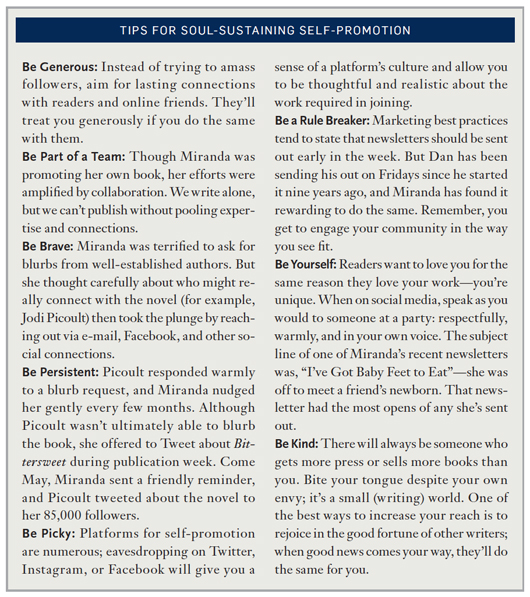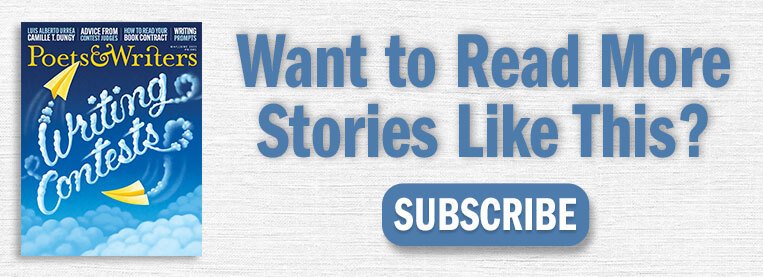Launching an E-Mail Newsletter
For the past nine years, Dan has been sending out a weekly newsletter on Friday mornings. He writes long pieces to help writers and creative professionals develop an audience without feeling overwhelmed. Dan always includes a personal touch: a picture of his son and a picture of his favorite meal of the week.
Unsure of what she’d say in her own newsletter, Miranda got an account with the e-mail marketing site AWeber. She wanted to use her contact list from 2007, when she’d sent out blasts from her personal e-mail, but Dan reminded her it was better to have ten loyal subscribers than a hundred who don’t feel invested. So she started over, asking friends and supporters—on Facebook, Twitter, and via e-mail—if they’d like to sign up for her revamped newsletter. She is now in the weekly habit of sharing her creative process and the daily ins and outs of her life.
After the first few blasts went out, Miranda got a concerned e-mail from her editor, wondering if this new project was too frequent and in-depth. Would casual readers of Bittersweet really want to receive this much content every week? This feedback helped galvanize Miranda’s definition of this project: The newsletter isn’t for book promotion—or at least not exclusively. Rather, it’s about creating long-term connections with people who will remain invested in her work ten years from now. Realizing that folks can unsubscribe if they don’t like how often she pops up in their inbox has been liberating.
Since then she’s written about her son’s preschool graduation and the loss of her grandmother, along with more professionally related topics such as upcoming readings and hitting the best-seller list. Every week she receives warm responses from a few subscribers, reinforcing the choice she’s made to remain a constant in their lives. She passes out a sign-up sheet during readings, netting subscribers with every appearance she makes. Writing the newsletter is now a reflexive part of her weekly ritual; its recipients have become a community. She has recently started giving away her favorite books each month as a thank-you for their support.
Creating a Compelling Giveaway
Seven weeks before publication day, we were antsy. We’d accomplished most of our long-term goals but wanted to do more. Then Julia Fierro—whose debut novel, Cutting Teeth, was published by St. Martin’s Press the same day as Bittersweet—mentioned that she had dozens of friends with books being published in the summer of 2014, and an idea for a big, bold giveaway was born. Miranda would take on the bulk of the administrative work; Fierro would cohost by inviting her friends to participate; and Dan would manage the technical side—from the legal language, to building web pages, to managing the software. We hoped this giveaway would support writers, reward readers, and create community.
We decided to give away one book per day, building to the grand prize (which we found ourselves drooling over): One lucky reader would win every single one of the books. Twenty-four authors agreed to participate, including Emma Straub, Roxane Gay, and Megan Abbott, each pledging to send two signed first editions to the winners of their books. We built a daily webpage for each individual giveaway, using a Proust-like questionnaire to create in-depth profiles of each featured author and book. We came up with a name (“OMG! All the Books!”) and an image, settled on a Twitter hashtag (#OMGbooks), and shared these materials with our participants so they, and their publicity departments, could help us spread the word.
Since Miranda was doing the bulk of the organizational work, she hosted the giveaway on her website. The result: Twenty-four writers spent five weeks boosting one another and mentioning Miranda’s website and the giveaway on social media. It was rewarding to build genuine, lasting connections with so many other writers—a good bunch of whom had probably never heard of Miranda. And remaining a steady, positive online presence exemplified the community-building we’d been aiming for all year. It was so much unexpected fun that we’re considering making it a tradition.
You never know what will work before you try it, and this was true with one of our projects, a stand-alone blog called FriendStories.com. At the heart of Bittersweet lies a complicated friendship between two young women; when Miranda talked about the book, many of her friends responded with their own tales of girlhood connection. The author envisioned a website where women could share these tales.
We hoped spreading the word about Bittersweet within a community engaged around the topic of friendship would prove valuable. After all, Miranda was starting June, also centered on a set of childhood best friends; building a project that linked her books was exciting. Dan designed a website, and Miranda solicited stories from her inner circle. Once she’d gathered two months’ worth of content, she began posting pieces twice a week.
The submissions to FriendStories.com were hysterical, heartrending, and honest. But as Miranda ran out of personal contacts, it became harder to get potential contributors to take the leap. So many hours had to go into soliciting, nudging, honing, and posting each piece that sustaining the blog became unrealistic. It had failed to gain its own momentum, and she decided to put it on hold.
From the standpoint of supporting Bittersweet, FriendStories.com was a flop. Yet with such a compelling topic at its heart, perhaps the project will re-emerge in a new form. Looking at it as an iteration of something larger, we don’t yet know what its value will be, and every misstep offers its own lesson.
Published on May 13, 2014, Bittersweet spent three weeks on the New York Times hardcover best-seller list. Although there’s no way to know which of our efforts helped place it there, it was thrilling to see the network we’d created—Twitter followers, Facebook friends, and newsletter subscribers—so eager to spread the good news.
Our efforts were greatly amplified by the hard work done by the rest of Miranda’s team—her agent, editor, publicist, marketing crew, and all the people at Crown. This is a point often lost in the thousands of articles online about “what makes a best-seller.” Building an invested team that communicates well may not be glamorous, but it is an essential foundation for self-promotion.
While we might have done a few things differently—from anticipating the unsustainability of FriendStories.com to cracking the Facebook author page—we have been glad to learn from our mistakes, and grateful that the Internet easily embraces change. Dan has deepened his understanding of how best to energize the full year prior to publication, and continues honing this work with other authors. And Miranda is relieved that our efforts created something sustainable, connecting her audience from Bittersweet to June, which will be published in 2016. Now that she’s established her community, she can pull back and focus on the part of her job she truly loves: writing.
Miranda Beverly-Whittemore is the author of three novels: The Effects of Light (Warner Books, 2005); Set Me Free (Warner Books, 2007), which won the Janet Heidinger Kafka Prize; and the New York Times best-seller Bittersweet (Crown, 2014). Winner of the Crazyhorse Fiction Prize, she lives in Brooklyn, New York.
Dan Blank is the founder of WeGrowMedia, through which he helps writers share their stories and connect with readers. He has worked with hundreds of writers, and with organizations such as Random House, Workman Publishing, Abrams Books, Writers House, the Kenyon Review, Writer’s Digest, Library Journal, and many others.









